You’ve probably noticed that guitar amps come in various shapes, types, and power outputs. So, what size guitar amp do you need? Choosing the right amp can make all the difference in the way your guitar sounds and plays.
In this article, I’ll reveal everything you need to know to choose the guitar amplifier that suits your playing style and budget.
You can use the table of contents below to take you to the area that interests you. Click on the little box to open it, and then click on the section of the article you want to read, or you can read from start to finish if you want the full guitar amp experience!
The Short Answer
Get the amplifier size that will give you the sound and volume you want for the kind of music you play and the size audience you perform for. An increase in amp wattage doesn’t mean the amp volume will increase by the same amount. For example, a 100-Watt amp is not twice as loud as a 50-Watt amp. It’s also essential to consider things like amp type, purpose, genre, venue, budget, brand, and company reputation.
Keep On Reading (Below) To Learn More
What Is A Guitar Amplifier?
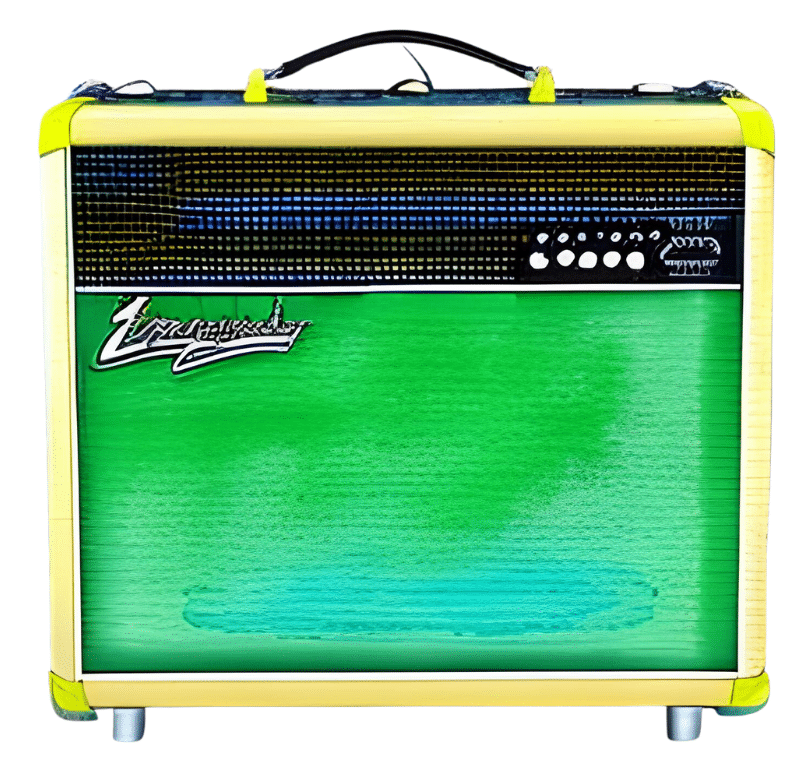
So, very simply, a guitar amplifier is an electronic device that takes a weak audio signal from an electric or acoustic-electric guitar and makes it louder.
It has a preamp section that shapes the sound of the guitar’s audio signal and a power amp section that amplifies the signal from the preamp section.
The amplified audio signal needs to be sent to one or more speakers to create the sound. The amplifier and speaker can be built into one cabinet, like the AI-generated image above, or they can each be in a separate enclosure. More about this is in the section below on types of guitar amplifiers.
Some guitar amplifiers can use headphones instead of the speaker(s).
Things To Consider When Choosing An Amp Size

When I first started playing, I wanted to buy the biggest guitar amp that I could buy, but there’s more to it than that! That are many things to consider before you make your choice.
You can click the blue links in the left column to go directly to that topic.
| Consideration | Examples |
|---|---|
| Power Rating and Volume | Watts Vs. Decibels |
| Amp Type | tube vs. solid-state vs. hybrid vs. modeling |
| Size Range | micro vs. mini vs. combo vs. stack |
| Purpose | home vs. gig vs. recording studio |
| Genre | country, rock, blues, metal, etc. |
| Venue | small vs. medium, vs. large |
| Budget | basic vs boutigue |
| Brand and Reputation | Fender, Marshall, etc. |
Keep On Reading (Below) To Learn More About Each Topic
Power (Wattage) Versus Volume
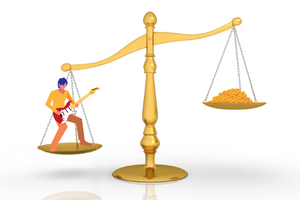
The size amp you need is related to an amp’s power output and the sound volume it creates.
The power rating of an amplifier is measured in Watts, whereas volume is how loud the sound coming from an amplifier’s speakers is to the human ear. Volume is related to sound pressure level and is measured in decibels.
Generally speaking, the bigger the amplifier, the higher the amplifier’s wattage, and the louder (more volume) the amplifier may be, but not always.
In addition, an increase in amp wattage doesn’t mean the amp volume will increase by the same amount. For example, a 100-Watt amp is not twice as loud as a 50-Watt amp.
The wattage rating comes from the amp’s power section, but the guitar amp may also have multiple gain stages in the preamp section that can make one amplifier of the same power rating much louder than another.
Take a look at this table that shows the loudness of four different amplifiers compared to an amp with a power output of 1-Watt. See how the loudness is non-linear? So, a 10-Watt amp is only 2 times louder than a 1-Watt amp, not ten times louder!
| Power (Watts) | Approximate Loudness Compared To A 1-Watt Amplifier |
|---|---|
| 10 | 2 Times |
| 20 | 2.6 Times |
| 50 | 3.2 Times |
| 100 | 4 Times |
However, if your amp can’t give you the clean sound you want at high volumes, you may need a “bigger” amp with more power, which will provide you with more “headroom.” So an amp’s headroom is the power your amp can provide before the sound starts to break up and distort
Now, if you compare two guitar amplifiers with the same type and specifications of preamp and amp sections, there are three main things that can affect the volume of each one.
Vacuum Tube Versus Solid-State
Tube amps are generally louder than a solid-state amp of the same power rating. Some tube amps are louder than higher-powered solid-state devices.
Speaker Design, Number, and Configuration
Things like speaker size, impedance rating, number (1 vs. 2 vs. 4), the way they are connected to each other (in series vs. parallel), and the type of cabinet they are housed in (combo, stack, open-back, closed-back) can all affect the volume and sound characteristics.
Amplifier Input Signal
The more powerful the audio signal going into the guitar amplifier, the louder the amp is likely to be.
Guitar pickup design matters. Humbucking (double-coil) pickups can make the amplifier louder than single-coil pickups.
Some effects boxes, like an overdrive, distortion, or fuzz pedal, will amplify the guitar signal and make it stronger before it enters the preamp section of the guitar amp.
Increasing the amplifier input signal can make the guitar amplifier distorted (non-linear). So, if you’re a lead guitarist playing Metal, you probably want an amplifier that gives you a musically distorted sound. However, this could be a problem if you want a clean sound, like a Jazz guitarist playing rhythm.
Types Of Guitar Amplifiers
There are four main types of guitar amplifiers, and each of them comes in various sizes. So, the type of amplifier you use is more related to sound quality than how big the amp is.
I have amps in all four categories below, and they each have strengths and weaknesses.
Tube Amplifiers
In the beginning, vacuum tube amplifiers were the only game in town. It was the only way sound could be electronically amplified. Despite the fact that they were heavy and clunky, they had a very organic sound that gave guitar players a mild creamy distortion when pushed hard with the volume control maxed out.
These days, tube amplifiers are among the most expensive models, which are still prized for their warm, rich, and natural sound. They sound great, no matter which musical genre you play.
For example, Jazz players like their clean sound, while Rock and Blues players love the way they break up and sustain notes!
Solid State Amplifiers
Solid-state (transistor) amplifiers are typically cheaper than tube amps and can be used in any musical genre. Therefore, they are a great choice for beginning players, although many pro players use them too.
Solid-state amps are not inferior to tube amps, but they don’t have the “power sag” that produces that classic warm and organic sound. Instead, they have a cleaner, brighter, and more consistent sound. They are also more reliable than tube amps, which can fail in a variety of ways.
Don’t hesitate to consider a solid-state amp, no matter what type of music you play.
Hybrid Amplifiers
Hybrid amplifiers combine the best of both words. They typically have a tube preamp stage with a solid-state power amp stage to give you a tube amp tone and a more cost-friendly and reliable unit. They can give you the warmth and natural sound of tube amps with the reliability and affordability of solid-state amps
You might be surprised how versatile these amps can be. I have a Marshall Valvestate AVT 20 combo amp that gives me a variety of sounds. True, I can’t compare it to my all-tube Marshalls, but it has a unique tone that keeps it in my amp collection.
Modeling Amplifiers
Modeling amps allow you to have a variety of classic and new amp designs available by simply changing a few settings. They used sophisticated computer chips to modify the amplifier’s sound to give you anything from the clean jazz sound of a Roland C-40 Jazz Chorus combo to the Metal monster roar of a Marshall DSL100HR 100-watt stack!
Even the lower-cost modeling amps can create some impressive tones, while the higher-end models have high-definition sounds that can sound like the real thing.
If you play a variety of styles and you have the cash, take a serious look at modeling amps!
Pros And Cons Of Amp Size
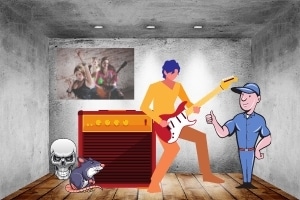

Bigger is not necessarily better when it comes to guitar amps. Here’s a quick look at some of the four size ranges’ most important pros and cons.
| Amp Size | Pros | Cons |
|---|---|---|
| Micro | Cost less, Great for bedroom practice | Lower sound quality Volume Limitations |
| Mini | Typically louder than micro amps Ok for low-volume band practice | Sound quality can be an issue Not usually “gig-ready |
| Combo | Easy to transport Good for small venues | Can be expensive Not as loud as a stack amp |
| Stack | More speakers than combo amps Better for large venues | More difficult to transport More expensive than combo amps |
Keep On Reading (Below) To Learn More About Each Topic
Why Guitar Amplifier Size Matters
Guitar amplifiers come in a wide variety of sizes, ranging from amps small enough to fit in your pocket to stack amplifiers as tall as the rock star standing in front of them!
Here are the four most common sizes of guitar amplifiers.
Micro Amps
A micro amp is the smallest amp you’ll find. They are mostly battery-powered, although some have the option to attach a power adaptor. If you’re looking for something that is cost-friendly and suitable for bedroom practice, this could be the way to go, especially if you’re playing alone.
Volume and sound-quality issues are the biggest limitations, but they might be just the amp to let you avoid annoying other household members.
They typically have one small 2 to 3-inch speaker, although others only have a headphone jack.
I’ve tried many micro amps in the past. They’re great for taking anywhere you go, and some are small enough to fit inside a guitar case.
I particularly like the sound of the Marshall MS-2 half-stack micro. I use one on my guitar workbench, and the battery lasts forever! It has a Volume and Tone control, an Off-On-Overdrive switch, and 1-Watt of power.
It definitely has the Marshall sound!
Mini Amps
Mini amps are bigger than micro amps and usually give you more sound options and volume. They sit somewhere in between the micro and the combo amps in terms of size. These amps commonly have one 4 to 6-inch speaker.
Minis make great practice amps, even in a low-volume garage band format, but don’t expect to use one at a gig unless you plan on mixing it through the PA system.
You could get away with using one in a small venue like a coffee shop, a small bar, or busking.
I love Orange Amps, and they make a killer mini version that I use when I play at home on my couch. This 3-Watt Orange Mini Crush has a 4-inch speaker, Volume, Gain, and Shape controls, a built-in tuner, an aux input jack for playing with background tracks, and an 8-Ohm speaker output. It runs on a battery or with an AC adaptor.
You should definitely check it out if you’re looking for a mini amp!
Combo Amps
Combo amps are all-purpose units that fit somewhere between a mini and a stack amplifier. They generally have better tone than a mini amp but don’t push as much air as a stack configuration. Combos are the most gigging amp.
If you’re going to be playing in a band, a combo amp is an excellent choice! The amplifier and speaker(s)are housed in the same cabinet, so it’s portable but can have the power you need to get your guitar out in front of the band.
They’re great for home use, too. I have over a dozen combo maps in my music studio, and they all sound and perform differently.
They usually come in a power range of about 20 to 100 Watts but can go down as low as 5 watts. Combo guitar amps typically have 1 or 2 ten-to-twelve-inch speakers. Most boutique amps are mini, which have a luscious tone and a hefty price tag.
One of my favorite combo tube amps is the Vox AC15. It has a Normal and Top Boost input with a Master Volume and Tone Cut. It has that classic Vox British glassy sound that only EL-84 power tubes can give you. This amp has 15 Watts of power and one 12-inch speaker. Nothing sounds like a Vox tube amp, and I’ve had this one in my collection for almost 30 years!
Stack Amps
Stack amplifiers are designed to move a lot of air and really make some noise. They have the amplifier (head)in one cabinet and the speakers in another. This “split design” makes it easier to transport and lighter to lift.
The amplifier head can power a single speaker cabinet (half stack) or two speaker cabinets (full stack). Each speaker cabinet typically contains four 12-inch speakers, so a full stack amp powers eight speakers.
These amps are designed for big gigs and outdoor performances. They come in 50 to 200 Watt power configurations, although some low-powered amp heads are available, which are more cost-friendly and give you a big sound at a lower volume.
Although a variety of companies make stack amps, Marshall was first in the design and coined the term “Marshall Stack.” For example, Blackstar also makes excellent stack amps.
Stack amps also have that ultra-cool Rock and Metal mojo that players like Jimi Hendrix flaunted so well. What rocker wouldn’t want to stand onstage in front of an iconic “wall of Marshalls?”
These days, I’m using a Marshall DSL100 (100 Watt) head with one 4X12 slanted Marshall cabinet loaded with four Celestion Greenback speakers. I love the Marshall “growl” it gives me at fairly low volumes.
This two-channel amp has four EL-34 power tubes that give me creamy overdrive through the Classic Gain channel and great Heavy Metal distortion through the Ultra Gain channel.
If you’re thinking about getting a Marshall half-stack, Amazon has a great deal on a Marshall bundle with a DSL100HR Head and an MX412AR angled Cabinet. The cabinet comes loaded with four Celestion G12E-60 speakers! Definitely worth a look (not currently available as a bundle at Guitar Center).

Half Stack
Click HERE To Check Reviews & Price On Amazon
The Magic Of The Master Volume Control
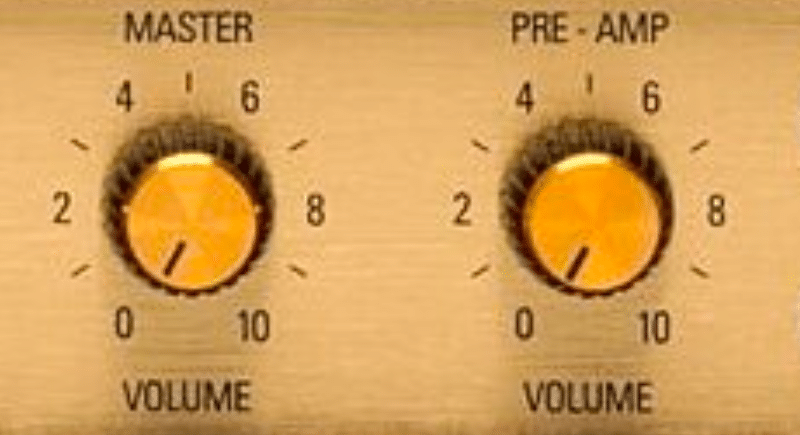
If you’re someone that loves getting natural distortion from a high-powered guitar amplifier at different volume levels, then check out models that have a master volume.
For example, what if you love the sound that only a Marshall double-stack can give you but want to use it for onstage performance and in your bedroom for practice sessions? Without a master volume control or a power attenuator, you might end up with some cranky neighbors or roommates!
An amp with a master volume control allows you to turn down the power section and crank the preamp to distort the sound at your desired volume level. High-gain amps have multiple gain sections in the preamp to really spike the incoming audio signal from the guitar.
So, if you want to use your “colosseum-size” amp in places big and small, the moral of the story is to get one with a master volume control!
Five Key Things That Determine Amp Size

So, here are some things you should be thinking about before you make your amplifier purchase, especially if it’s an expensive item. Choosing the right size amp can depend on these five factors.
Purpose
How do you plan on using the amplifier? Are you going to use it for practicing at home, playing gigs, or recording in a studio? Each option can have its own unique set of requirements.
If you’re practicing at home, a smaller amplifier with lower wattage may be ok. However, if you plan on playing gigs, you’ll need an amplifier with higher wattage to ensure you can be heard over the crowd. Finally, for recording in a studio, an amplifier with a more specialized sound and tone could be more important than its size.
It’s essential to carefully consider your needs and select an amplifier that will meet them effectively.
Genre
What type of music do you play?
Different genres require different types of guitar amps. For example, if you play very loud music, like heavy metal, you may need a high-powered, high-gain amp. I’m talking something like a Marshall stack here!
Conversely, someone like a jazz player will probably be fine with a smaller amp that has a clean, warm tone.
Venue
When you’re not playing at home, what type of venue will you be performing in?
Small venues, such as coffee shops or small bars, may only require a small or medium amp, like a mini or a combo.
Larger venues like clubs or theaters may require a combo amp or a stack.
You can always buy a smaller amp and mic it through the PA system if you end up playing a larger venue.
Budget
Don’t just go for the biggest size amplifier available; think about what you actually need in your price range.
Amps can sell from less than a hundred dollars to several thousand dollars, so before you start shopping, it’s a good idea to figure out what’s the maximum amount of money you have to spend.
This will save you a lot of time and could even end up saving you some hard-earned cash!
Brand And Reputation
Last but not least, is there a brand of guitar amp that you prefer? I ask that because the amplifier brand and model can definitely be a determining factor in the size you’ll need.
Some amp models with the same audio output power (wattage) can be louder or softer than others. Things like tube versus solid-state, transformer size, and speaker type call all be determining factors.
Different brands also have different reputations for quality and sound. So, be sure to research various brands and read reviews before making a purchase.
Always Try Before You Buy!
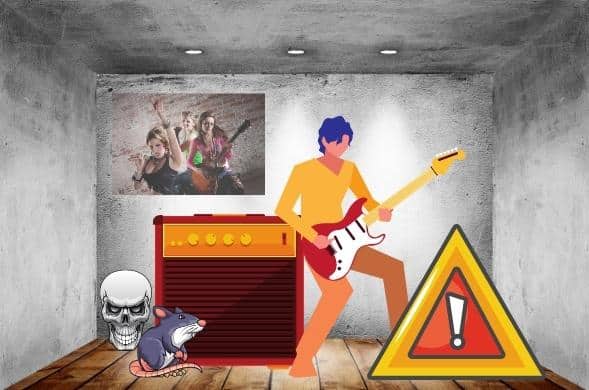
It’s a good idea to try before you buy a guitar amplifier, especially if you plan on putting down a lot of cash.
If you’re buying the amp online, try to play through something very similar to it at your local music store. Make sure the amplifier is returnable, and ask about free return shipping. Guitar amps can be heavy, so you don’t want to be stuck paying a big return shipping expense!
The other option is to check out some YouTube videos that review and demonstrate the amplifier’s sound using various guitars and effects pedals.
Things like the guitar you use and your playing style or technique can affect how the amp will sound.
Frequently Asked Questions

Here are some of the questions I get asked about guitar amp sizes.
If your question does not appear here, please put it in the comments, and I will get right back to you with an answer.
Is A 100 Watt Guitar Amp Loud Enough For Gigs?
A 100-Watt guitar amp is plenty loud enough for most gigs. If you’re playing in a very large venue or outside, you may have to mic your amp through the PA system.
Guitarists that play arenas or stadiums typically have more than one amp and mic at least one of the speaker cabinets into the PA system.
What Is A Good Size Guitar Amp For Home Use?
Anything from 5 to 20 watts will be more than adequate for bedroom use. However, if you are playing with the rest of your band, you might prefer a 50-watt amp. An amp with a Master Volume control will allow you to get overdriven or distorted sounds at a very low volume.
Should I Upgrade My Guitar Or Amp First?
The answer depends on what you are trying to accomplish. Upgrade to a more powerful amp if you need a lot more volume.
For amps that are clean, even at high volumes, you can upgrade to an amp with a Master Volume control if you want dirty sounds or keep that amp and add an overdrive or distortion pedal.
For amplifiers that have the sound you like but you’re looking for a different tone, think about trying different guitars with it until you find the sound in your head.
Does A Bigger Amp Mean Louder?
No, not necessarily. Tube amps are typically louder than solid-state amps of the same power rating. Amp volume can also vary widely from one brand to another.
Amplifiers with big differences in audio output power will definitely have noticeable volume levels. For example, a 100-Watt amp will definitely be louder than a 5-Watt amp.
Can You Have Too Big Of An Amplifier?
I would have said no when I first started playing over 50 years ago. Lol!
However, there are several disadvantages to having a very big amplifier. It can be heavy and too bulky to transport easily. Also, really high-powered amps are nosier than smaller ones.
Smaller amps make it easier to get natural distortion by cranking the volume without sounding too loud.
Are Small Guitar Amps Better?
Think about getting a smaller amp if you are playing by yourself in a small space, like your bedroom. Also, smaller amps are easy to push into overdrive at a lower volume.
If you have a limited budget, a smaller amp may be the way to go, although some small boutique amplifiers can be very expensive.
How Do I Know If My Amp Is Too Small?
You might need to upgrade the size of your guitar amplifier if you’re getting drowned out by the rest of your band or if your amp is distorting at higher volumes and you don’t want it to. The other option is to mic your amp into the PA system to make it louder.
Final Thoughts

So, I hope you found this article on what size guitar amp do you need helpful! Choosing the right size guitar amplifier is essential for achieving the sound and volume you want.
When choosing an amp size, it’s essential to consider things like power rating and volume, amp type, size range, purpose, genre, venue, budget, brand, and reputation.
Tube, solid-state, hybrid, and modeling amplifiers all come in various sizes. So choose one of these amp types that will give you the tone you need, and then pick the size you need for your volume requirements. These amp sizes are typically grouped into micro, mini, combo, and stack categories.
It’s a good idea to try an amplifier, if possible before you buy it. If you can’t, listen to the amp’s sound on a YouTube review to help you decide if that particular make and model is for you.
Here’s a great video from Wampler on the subject of “Are low-wattage guitar amps better than high-watt amps?” Be sure to check it out; you’ll love it!
Related Article ➡ Best Combo Guitar Amps For Any Budget: 5 All-Tube Beauties!
What To Read Next ➡ Is 50 Watts Enough Headroom For A Guitar Amp? – Full Guide!
Related Article ➡ 8″ vs 10″ vs 12″ Guitar Amplifier Speakers – Which Is Best?!
Tell Me What You Think

Please leave a comment below if you enjoyed this article, have any questions about guitar amp size, or want to give your point of view. I will be happy to help you.
- Are you looking to trade in your guitar amp for something bigger or smaller? Why?
- Do you prefer a smaller amp mixed into the PA system or a larger stand-alone amp? Why?
- How cool would it be if you could play through a wall of stacked amps?
- What else is on your mind?

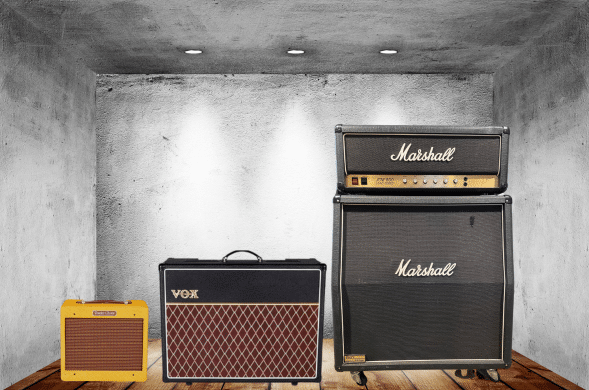
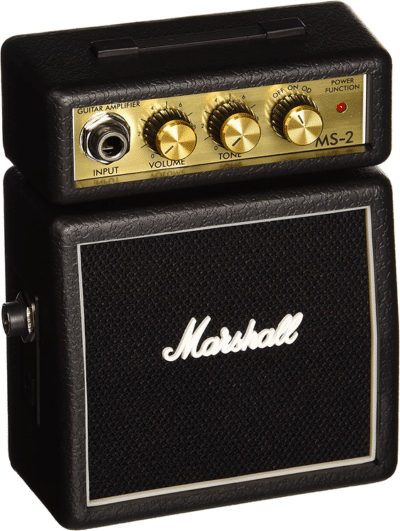
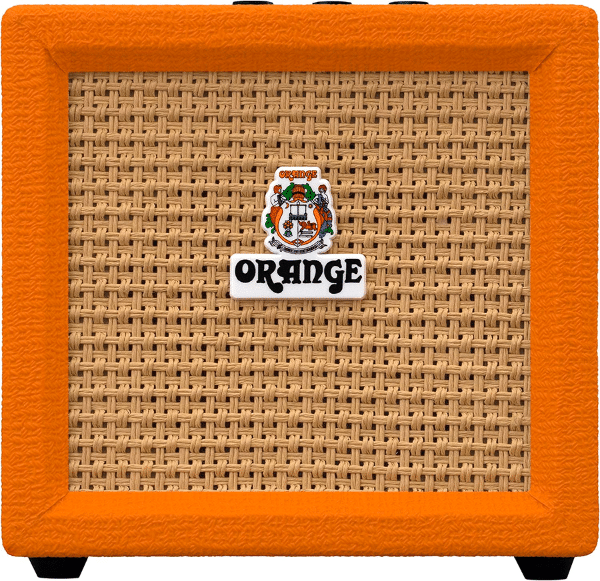
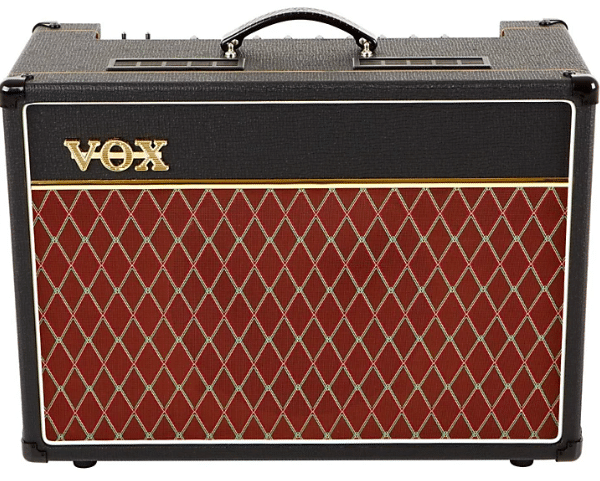

Hi Frank,
Thanks for providing this comprehensive guide on choosing the right size guitar amp. It covers all the essential aspects and considerations when making a decision. The table of contents is helpful for navigating through the article, and the explanations are clear and concise.
I appreciate the emphasis on understanding power (wattage) versus volume and how it’s not a linear relationship. The discussion on different types of amplifiers, including tube, solid-state, hybrid, and modeling amps, is also informative and gives readers a good overview of their options.
Overall, this guide is a valuable resource for anyone looking to choose the right guitar amp. It covers all the necessary factors and considerations, allowing readers to make an informed decision based on their playing style, genre, venue, and budget.
Hi, Wallace
Thanks so much for your comments!
Yeah, choosing the right size amp can be essential, especially if you’re buying your first one.
Let me know if you have any questions, and I will be happy to help! 😎
Rock On! 🤘
Frank 🎸
Hi Frank, I think this is a great guide on how to choose the right size for a guitar amp. In my case, I don’t really have to choose as my dad got a Fender Frontman 10G Guitar Combo Amplifier. He uses it for practice and sometimes he brings it over to some small playing gigs. I play for fun at my father’s studio and just plug it into my guitar, and I think sounds just about right in my opinion. Reading from your post here, maybe I should consider getting a micro amp. Could be handy if I want to bring around places to play my electric guitar.
Hi, Dominic
That’s great! The Fender Frontman 10G is a good-sounding combo amp, and it’s very versatile, too.
Micro amps are an excellent choice for their portability and affordability. I have a Marshall and a Vox micro amp. They give me a quick way to plug in my guitar when practicing and get a sound I like.
Rock On! 🤘
Frank 🎸
When I first started playing the guitar, one of the things that intimidated me was figuring out what size amp to use. It can be overwhelming to choose between all the different wattages and speaker sizes available. However, after doing some research and experimenting with different amps, I found that it really depends on your goals as a musician. If you’re just practising at home or playing small gigs, a lower wattage amp with a smaller speaker might be sufficient. But if you’re performing for larger audiences or recording in a professional studio, you may want to invest in a higher wattage amp with a bigger speaker for more volume and clarity. Ultimately, it’s important to consider your individual needs and preferences when choosing the right size guitar amp.
Hi, Akumendoh
Thank You for your comments!
Yes, a wide variety of amplifier designs and speaker sizes are available for any playing situation. You can always start with a mid-size 10-inch speaker, which should serve most of your requirements, and branch off from there.
Rock On! 🤘
Frank 🎸